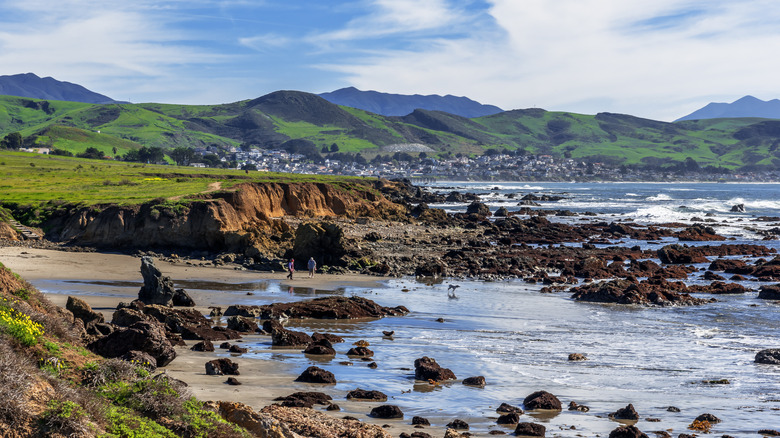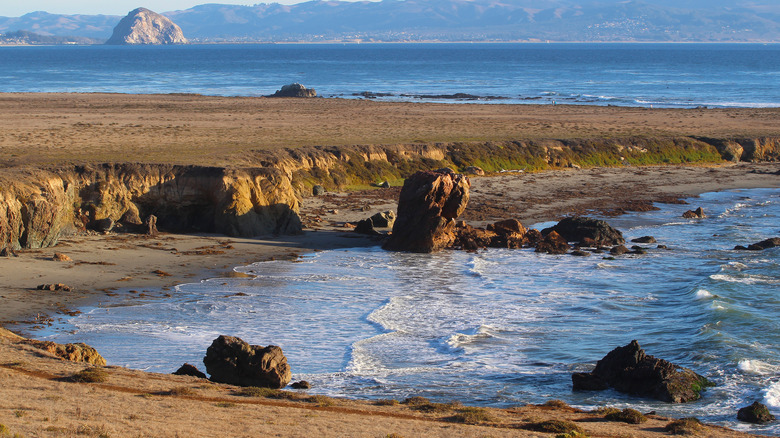The Central California Coast's Most Underrated Destination Is A Picturesque Wildlife-Filled State Park
Fitting for a spot among the most incredible California spots to visit, Estero Bluffs State Park can be found right along the Golden State's central coast. Hugging the lapping waters of the Pacific Ocean just north of the coastal town of Cayucos, this beautiful preserve straddles the rocky strip of coastline just west of Cabrillo Highway, also known as Highway 1, for about 355 acres.
Marine terraces, coastal grasslands, marshy wetlands, and scenic bluffs are undoubtedly the stars of the show when it comes to this stunning and incredibly diverse stretch of wilds. That and the striking sea stacks dotting the waters along the park's 4 miles of shoreline. Estero Bluffs State Park's rather unique rock formations are part of the Franciscan Complex, an ancient and eclectic strip of igneous, sedimentary, and metamorphic rocks that cropped up anywhere between 80 and 200 million years ago.
Of course, Estero Bluffs State Park itself is relatively new. It only dates back to the early aughts when the Trust for Public Lands nonprofit bought the land in 2000 to save it from becoming a sprawling coastal resort. The organization deeded it to the state two years later, allowing locals and passersby to continue gawking at its sheer beauty for time to come. One of the best things about the land, which once served as cattle farms for missions in the late 1700s to early 1800s, is that it's teeming with wildlife. Among them are several endangered species, like the adorable little shorebird known as the snowy plover, making it the perfect place to explore if you really love — and respect — nature.
See the stunning wildlife at Estero Bluffs State Park
From mule deer and coyotes to cottontail rabbits and even skunks, a variety of other creatures call Estero Bluffs State Park home. Get a good view of the coast to find otters and seals resting along the sandy shores. And if you visit during the cooler months, you may even be able to spot gray whales migrating south in the winter. What's more, the park could land on a list of the best birdwatching destinations in the U.S. because there are plenty of birds to see in the area, too. Songbirds, bushtits, black oystercatchers, cormorants, red-tailed hawks, and pelicans can also be seen creeping along the shore or clipping through the tranquil skies.
To catch sight of some of the park's most precious critters, take a hike on the Estero Bluffs Trail, which winds along the coast for about 4 miles. The scenic coastal bluffs and rock formations — not to mention, the sprouting seasonal wildflowers that are a staple in the springtime — dotting the way rival any of the views found in some of California's best coastal hiking trails, trumping even those of the Lost Coast Trail on the northern end of the state.
"It's beautiful and offers visitors a chance to experience the Pacific coast in all its glory," one past parkgoer shared on Tripadvisor, adding that you can see more marine life during the low tide, such as sea anemones and crabs. You can spy Morro Rock — a treasured gem of the nearby city of Morro Bay — in the distance and even a shipwreck offshore, the latter of which sits on the southern end of the park.
Things to know before visiting Estero Bluffs
Estero Bluffs State Park is calling your name, but before you make the trek out to the park, which is about a 30-minute drive from the San Luis Obispo County Regional Airport, there are a few important topics to cover. First up, operating hours. The park is a day-use area, so it's only open from 6 a.m. to sunset. That means there are no campgrounds, so you'll need to secure lodging elsewhere, like at the Castle Inn in Cambria or Morro Bay's Blufftop Inn & Suites.
Since the park's primary purpose is to preserve the surrounding habitats, it's largely undeveloped. You won't find any restrooms, drinking fountains, or other facilities along your hike, so definitely plan ahead. Bicycles and horses are not permitted within the park, but you can bring your dog so long as it's leashed and you don't go north of San Geronimo Creek.
As you meander along the trails, keep an eye out for poison oak as well as rattlesnakes and ticks, which are known to transmit Lyme disease. Always be respectful of the surrounding habitats, which are protected by law, and if you encounter any injured animals or marine life, be sure to let the proper authorities know. California's Department of Parks and Recreation recommends contacting the Marine Mammal Center for cases involving the latter, while the Pacific Wildlife Care organization in nearby Morro Bay can help with injured birds and land animals. Also, if you see any illegal poachers, reach out to Californians Turn in Poachers. As always, leave no trace and enjoy the view.


